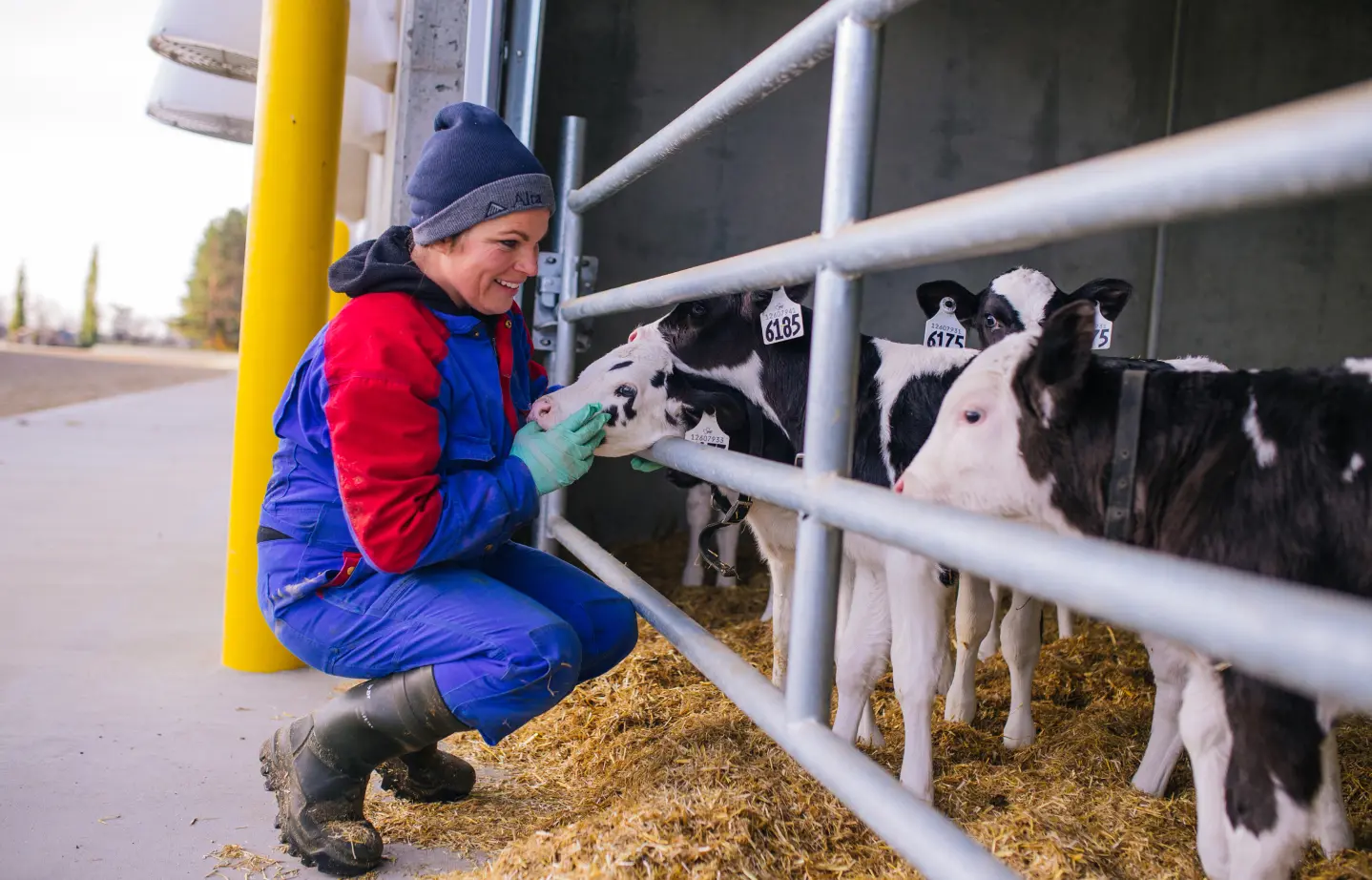
Vision, Mission, & Guiding Behaviours
Vision
Better Together for Canadian Dairy.
Mission
Inspiring, innovating, and collaborating to build a healthy Canadian dairy industry.
Guiding Behaviours
- Think bigger
- Win-win
- Fact-based
Executive Messages
Chair’s Message
As I reflect on this past year, it’s clear that the last year has been a shifting time for Alberta Milk. Our journey within the Western Milk Pool (WMP) has led to many valuable conversations and analysis of how all our organizations, and even our industry, do business and Alberta Milk is evolving in exciting ways as a result. The dedication of our staff and Board members has been instrumental in driving these changes, and we’re already reaping the benefits as we streamline processes across provinces with even more on the horizon.


General Manager’s Message
Better Together for Canadian Dairy: These five words have been the foundation of everything Alberta Milk has done this past year – nationally, regionally, and provincially. It is the lens through which we looked as we worked with our national colleagues including Dairy Farmers of Canada, Canadian Dairy Commission, and Dairy Processors Association of Canada, our Western Milk Pool partners, our industry service providers including transporters, our delegates and producers, and our staff who continue to work with their colleagues across the country and especially in the west.
General Manager’s Message
It is with great honour that I write my inaugural General Manager’s message for Alberta Milk since Freda’s retirement. This year marked a significant period of transition for myself and for Alberta Milk as an organization, while maintaining a substantial focus on collaboration both regionally and nationally.

Western Milk Pool Update
Western Milk Pool Update
Since the WMP transformation was first announced in the fall of 2023, the initiative has evolved. The original vision of establishing a centralized board to oversee the provincial organizations has shifted. Regulatory frameworks in each province have made structural changes and the creation of a central board unfeasible. As a result, the provincial structures will remain intact, but with an increased focus on enhancing interprovincial collaboration.
While the provincial organizations will continue as distinct entities, they will embrace a more collaborative approach. This shift reflects the need to adapt and work together more effectively, addressing common challenges while maintaining their independence.
Milk Production
Milk Production
The 2023-24 dairy year concluded with 468 dairy producers operating in Alberta, collectively shipping a total of 838,075,078 litres of milk
This represents 8.75% of the national milk production.
The province’s average butterfat content reached 4.30 kg/hl, reflecting a 1.70% increase over last year’s average of 4.23 kg/hl. Consequently, Alberta contributed 36,056,775 kg of butterfat to the Canadian dairy supply.
Milk Quality
Milk Quality
This year saw the continuation of the WMP Harmonized Progressive Penalty Program (PPP) through its first full year. Producer results show the lowest Somatic Cell Count (SCC) and bacteria (IBC) provincial averages on record!
These improvements reinforced Alberta producers’ commitment to being a trusted source of quality milk. Provincial PPP compliance numbers demonstrated that producers are consistently achieving very high milk quality standards.
These standards continue to assure Canadians that they are consuming quality milk.
Congratulations to the Neudorf Hutterian Brethren on winning the provincial milk quality award for the third time in the past 5 years!
Research
Research
Research Project Funding: Alberta Milk is supporting 23 active research projects with contributions totalling $1M, and an additional $11M leveraged from funding partners (2021 to 2024).

Sustainability
Sustainability
Alberta Milk participates on the national environmental sustainability working group, as a representative of the west. The working group supports coordination and collaboration on dairy sustainability and implementation of the net zero by 2050 target.
Recent activities include the early drafts of a business model to support dairy producers in benefitting from carbon reduction markets. The model will promote implementation of sustainability BMPs while ensuring a return on investment for producers.
The western provinces have also agreed to participate in a project pilot testing the Cool Farm Tool to measure individual farm carbon footprints. The tool will help producers evaluate the impact of management changes on farm and will serve as a reporting tool for participation in carbon reduction markets.
Alberta Milk is supporting several active research projects in sustainability, with focuses on:
- Feed additives to reduce methane emissions and forages that are more tolerant to extreme climates
- Optimization of crossbred calf management and performance
- Selection for more feed efficient cattle and evaluation of technology to measure individual cow methane emissions

proACTION®
The western proAction Coordinators (PCo’s) continued their harmonization work which began in February 2023. The biggest achievement to date is the introduction of the Phase 1 harmonized processes that will come into effect September 1, 2024.
These changes reflect full interprovincial harmonization on policies and administrative processes at the office and farm level. Work on Phase 2 harmonization, which includes moving towards harmonized compliance policies and other Board-level approval pieces, is also underway.
Transportation
Transportation
Alberta Milk collaborated with producers, milk transportation companies, dairy processors and our Western Milk Pool (WMP) provincial partners to ensure that the most cost-effective transportation logistics were exercised for both provincial and interprovincial loads of milk.
There was an increase in the volume of milk delivered to British Columbia for additional processing that was available in the WMP.
Below are a few provincial transportation statistics:
Average number of routes every two days: 175 (174 in 2022 – 2023)
- 1 tandem route: (1 tractor) Utilized for partial deliveries in Edmonton.
- 158 Triaxle routes: (56 tractors) Utilized for single, double, triple and interprovincial loads.
- 16 b-train routes: (8 tractors) Utilized for interprovincial loads.
Number of milk transportation companies: 13
Market Development and Community Engagement
Market Development and Community Engagement
Building on work done over the past few years, Alberta Milk continued to partner with BC Dairy on a series of marketing campaigns and community engagement activities building pride and confidence in local dairy.
We’ve seen really positive results over the past year. As of the end of July, 78% of Albertans feel positive about dairy farmers, this is a 5 point increase compared to the previous year.
Nutrition
Nutrition
As 2023 saw the realization of the Nutrition programs of AB, SK, MB come together under one united Western plan, 2024 saw the reorganization of the program to have a Regional Director (Kenton Delisle, AB), a senior advisor (Pat Bugara Krawchuk, MB). Two Senior Managers are in place at the start of 2024 to support the school and ECE sectors across all 3 provinces, without adding to the existing staff complement, and to streamline processes among staff to foster one western team.
2024 is the 75th anniversary of dairy funded nutrition education in Alberta!
Since 1949, when Municipal Dairy Foundations started supporting nutrition education, dairy farmers have been investing in their communities, while highlighting the unique role of dairy in people’s health, lives, economies, and communities.
Governance
Governance
Alberta Milk is governed by a board of directors (board), elected from a delegate body, to represent the interests of all licensed dairy producers in Alberta.
The province is divided into three regions: north, central and south. Each region is represented by an elected delegate body that forms the region’s committee.
The delegates support grassroots communication with producers and provide advice to the board on issues of importance to the industry.
The board sets policy and outlines the strategic direction of the organization through the Strategic Plan.
The board also works collaboratively with our regional and national partners to build a thriving dairy industry within Canada’s supply managed system.
Strategic Priorities
Strategic Priorities
In 2023, the Alberta Milk Board developed a new 1-year Strategic Plan, in conjunction with its WMP partners.
The General Manager is responsible for operationalizing and delivering on each of the key results areas. The board is kept apprised of this progress through regular updates and key performance indicator reporting.
The board established three Key Result Areas for the 2023-24 dairy year, with the following associated key performance indicators and targets:
Producer Engagement
Producer interactions:
80% of producers interact with Alberta Milk.
Provincial Leadership
Leadership pipeline:
50% of delegates meet the skills expectations for the board role.
Transformation
Rapport with Alberta Agricultural Products Marketing Council (Marketing Council) and provincial government:
Sign off by all Signatories to the Western Milk Pooling Agreement.
Alberta Milk continues to work collaboratively with our Western Milk Pool partners to find efficiencies and increase value for our producers, including harmonizing policies, sharing resources, and working together on key files.
Collaboration at the interprovincial and national level is crucial as industry issues increasingly impact all dairy producers, regardless of where they farm. Alberta Milk will also continue to build strong relationships with the dairy processing industry and work together on issues and opportunities of shared interest.
Federal Government Relations and Advocacy
Federal Government Relations and Advocacy
Government Relations
Nationally, we worked with our Dairy Farmers of Canada partners on many advocacy files including:
- Supply Management Bill C-282
- Dairy Innovation Investment Fund
- Protecting Biosecurity on Farms and Bill C-275
- New Greenwashing Provisions under Bill C-59
International Trade
- Trade Panels on Dairy TRQs
- CUSMA Review
- Canada-United Kingdom Bilateral Negotiations
Regulatory Affairs
- Front-of-Package Labelling
- Marketing to Kids
- Vitamin D Labelling
- Access and Approval of Antimicrobials and Alternatives
- Foot and Mouth Disease Vaccine Bank
- Protein Quality Assessment
- Grocery Code of Conduct

For more information on Finances and Regulations and Bylaws, read the full PDF report.